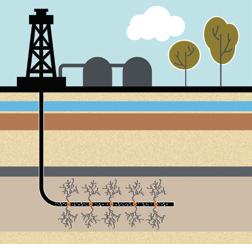
23 minute read
Public Policies Weighed as Industry Navigates
Public Policies Weighed as Industry Navigates Uncharted Waters
By: Jack Belcher and Brent Greenfield
Advertisement
The events of the last several months have been unprecedented. A global pandemic and oil price war unfolding at precisely the same time.
Rewind to 2019. Production was at an all-time high in the United States, but signs of a weakening global economy and demand and looming downward pressure on prices were evident. Exacerbating the issue, investment capital was becoming increasingly scarce as more investors turned against oil and gas due to eroding confidence in the future of fossil energy, poor market fundamentals, and a preference for returns over growth.
By early this year, overall industry performance was on the decline just as the pandemic started to impact energy demand in a way that mimicked the spread of the disease: a rolling thunder and then a giant crescendo as travel, commerce and transportation came to a virtual standstill. Then, Saudi Arabia and Russia sparked an oil price war. Although always an identified risk — the two countries had been at odds for some time and both wanted to inflict pain on U.S. producers — many were skeptical that they would actually open the spigots and flood the world with oil.
As the private sector took immediate steps to address the dour market conditions through reductions in exploration and production activities, the first public policy priority was to convince Saudi Arabia and Russia to end their dangerous and high-stakes market maneuvers. The United States, in particular, flexed its muscle in a successful effort to help stabilize oil markets.
Available Levers
Diplomatic
Trade
Regulatory
Legislative
Potential Actions
•Continued engagement/negotiations with OPEC+ countries (e.g. Saudi Arabia, Russia)
•Executive action to impose Sec. 232 tariffs on energy imports on national security grounds •U.S. Commerce Dept./International Trade
Commission action to provide antidumping relief through imposition of duties on energy imports •Executive action under the International Emergency
Economic Powers Act to restrict energy imports on basis of a national emergency
•Continued U.S. Dept. of Energy leasing of Strategic Petroleum Reserve (SPR) until it is completely filled (payable with barrels) •Royalty relief •Regulatory relief •Help ensure liquidity for energy companies (e.g. loan/credit relief) and their lenders •Federal lease/permit extensions •Streamlined project application/review processes •Waiver of Jones Act requirements to support domestic movement of energy products on national defense grounds •Expedited permitting (e.g. LNG) •Incentives for greater domestic refining of US crude oil •Federal study on importance of US o&g sector on energy security, economy, and environment
•Funding for new SPR purchases •Increase of SPR size •Support for US and global energy infrastructure projects •Tax relief •Support for Master Limited Partnership model •Incentives for greater domestic refining of US crude oil
The OPEC+ agreement to production cuts (albeit temporary), supplemented by additional reductions pledged by Saudi Arabia, Kuwait and the United Arab Emirates, was a welcomed move no doubt aided by the immense economic and fiscal pain shared by the Saudis, Russians, and many other nations. As governments and industry alike look for a more permanent fix, the new role of the United States in world oil markets and its status as a global power with an interest in a robust and stable price of oil all but ensures that new alliances will be formed to achieve a longer-term solution.
Complicating the current situation, the pandemic has and will likely continue to damage U.S.-China relations. As the world’s largest growing market and one of the world’s largest consumers of energy, China is likely to seek even deeper relationships with countries like Russia as it attempts to diversify its supply chain even while it continues to rely in part on U.S. energy and agricultural products to meet the country’s needs.
Furthermore, the pandemic will not deter environmental activists and the investment community from their efforts to secure lower carbon investment portfolios and stronger Environmental, Social Governance (ESG) performance. As one example, the Environmental Defense Fund recently released data they say indicates that methane emissions in the Permian Basin are significantly higher than previously believed, and is vowing to identify serious emitters in the coming months.
The Oil and Gas Industry is Not Dead
Make no mistake: the oil and gas sector is certainly not dead. Demand will return, although how quickly and at what pace remain uncertain. The pandemic has changed human behavior, and some demand destruction will undoubtedly be long-term or even permanent. For some companies and individuals, the pandemic has shown that it might not be necessary to drive to work in an office every day. It may take a while for people to feel comfortable about flying in crowded planes. At the same time, however, those returning to work might be more inclined to drive as subways, commuter trains, and buses all showed themselves to be instruments in spreading the virus.
In the United States, there is no shortage of domestic policy options that have been offered to address the impact of both the pandemic and the market oversupply. Yet action has been slow thus far amid the industry’s lack of consensus agreement on a path forward for possible relief.
Early on, initial purchases for the Strategic Petroleum Reserve (SPR) took some pressure off of the market, but not enough. After Congress refused to authorize funds for additional SPR purchases, and with most Democratic Commission. In addition to allowing producers to shut in unprofitable wells without losing a lease, the Oklahoma Corporation Commission considered one proposal to declare some current production in Oklahoma to be waste and another that would mandate production cuts. In North Dakota, the Department of Min
leadership emphatically continuing to declare their opposition to purchases and any “bailouts” for the oil and gas industry, the Department of Energy has offered up space in the SPR that producers can bid on, and pay for, with actual barrels, providing additional and helpful relief on a limited basin.
A Variety of Policy Proposals
Some in the industry and elected offices have called for direct intervention in the form of tariffs, antidumping duties or import bans. Three states explored options to deal with oversupplies themselves. An effort in Texas to “prorate” oil production was considered, but ultimately rejected by the Texas Railroad
eral Resources’ Oil and Gas Division mulled whether production levels constituted waste and if so, what relief might be appropriate.
Others floated the possibility of incentives for refinery modifications that would allow U.S. refineries to process more crude from shale plays. Refiners opposed the idea, stressing the need to keep the door open for crude oil imports, even as they struggled to find markets or storage space for their fuel.
Operators on federal lands and waters requested royalty relief, lease and permit extensions, and federal land reform. Other provisions included targeted items like regulatory reform, temporary suspension of Jones Act provisions, modernization and strengthening
Master Limited Partnership (MLP) designations, and expedited permitting for LNG export facilities. Oil refiners sought relief from renewable fuels standard requirements, while biofuels producers opposed those requests and sought federal relief themselves.
With such disparate needs and requests coming from the broader industry, and little appetite in Congress to do anything for fossil energy, very little targeted government assistance has been made available to the oil and gas industry. Rather, the primary focus has been geopolitical maneuvering to keep global production cuts in place, storage of crude oil in the Strategic Petroleum Reserve (which can be paid for in actual barrels of oil), and loans to oil and gas companies that need them.
However, President Trump has asked Energy Secretary Dan Brouillette and Treasury Secretary Steven Mnuchin to work together to find ways to provide loans to oil and gas companies that need them but are not likely to become insolvent. As of mid-May, that process remains underway.
For much of the past four years, there has been discussion about a potential bipartisan infrastructure bill that would direct federal funds to important projects such as roads, bridges, and ports. Such a bill could include provisions that are helpful to the energy industry and would support future U.S. energy demand and energy transportation. While there are continued discussions about an infrastructure bill, the clock is winding down, with the House and Senate still working on additional COVID-19 relief bills and passage of FY2021 appropriations bills. Of course, this all occurs as both bodies determine how to work without catching the virus and with the November elections upon us.
Amid the legislative activity, speculation and talk continues on a possible grand compromise that could provide relief loans, fund SPR purchases, and provide financial incentives for carbon footprint reduction technology, while at the same time providing support for renewables and addressing environmental issues like methane emissions. Such a compromise is never easy to achieve, and would be especially difficult to accomplish in the current environment. Notably, draft COVID relief legislation introduced by House Democrats included Green New Deal-type provisions, such as tying relief loans to the adoption of ESG standards. While the language was not adopted, it is likely a harbinger of things to come, especially if major changes occur in the upcoming presidential and congressional elections.
For now, it appears that the prospect for public policy solutions for the oil and gas industry are somewhat limited. In the short run, the administration’s diplomatic efforts have prevented further damage, but longer-term solutions on global supply are needed. Policies aside, however, the market will ultimately resolve the current crisis, and the industry may emerge as strong or stronger when it does. Signs have already emerged for a brighter near and mid-term landscape for natural gas, and the same is likely to unfold for oil as well. There is good reason for both, given the world’s growing energy demand.
That is not to say that there won’t be painful fallout from the current crisis. Sadly, there will be. Many companies will cease to exist and many workers have lost their jobs and many more will. Many will never return to the oil patch.
Emerging From the Abyss
As the industry reemerges from the recent abyss, it needs to start addressing the reasons why investors are shying away from oil and gas stocks. It needs to understand that investors value returns over growth, want to avoid companies with large debt and small margins, and value companies that are reducing their carbon footprint and addressing other ESGrelated factors. These trends will not be easy to address. While trade associations and public policy may play a role, it will mostly be up to individual companies to align themselves with investor needs and desires.
Against this backdrop, the need for more attention to risk assessment and mitigation has never been greater. While the unexpected cannot always be anticipated, companies can plan and better prepare for those moments when their organization, industry, or even the world at large are temporarily turned upside down. In the last 20 years, the United States has experienced Sept. 11, the financial crisis and accompanying Great Recession, and now the COVID-19 pandemic and global supply shock.
With history as our guide, we’re destined for more surprises, and as a core industry intertwined into every fabric of society, it is incumbent on the oil and gas sector to understand, prepare for and mitigate that risk, addressing every facet thereof, from labor and financial to operational and social and beyond. The industry has been through tough periods many times before and emerged with resilience. Although perhaps one of the most painful so far, with the right approach, this time will be no different.
About the author: Jack Belcher joins Cornerstone in 2019 with over 25 years of experience in energy and energy policy. As senior vice president of Cornerstone Energy Solutions, he provides strategic and tactical advice to energy and transportation companies and financial institutions, focusing on government relations, regulatory affairs, public policy, strategical communications, situational risk management, and Environmental, Social, and Governance (ESG) performance. Jack also serves as managing director of the National Ocean Policy Coalition.
About the author: Brent Greenfield serves as Vice President and Counsel at Cornerstone Energy Solutions. He provides clients with strategic policy and management guidance, research, analysis and communications support across the upstream, midstream, and downstream segments of the energy industry. In addition, Brent serves as executive director of the National Ocean Policy Coalition, an organization comprised of members representing sectors including energy, fishing, waterborne transportation, construction, agriculture, and critical infrastructure.

To Fix Flaring, Railroad Commission Must Tackle the Incentive Problem
By: Colin Leyden and Scott Anderson, Environmental Defense Fund
Aremarkable thing happened at the Texas Railroad Commission these past few weeks. Throughout the contentious debate over proration, a growing chorus of voices on both sides was calling on the commissioners to address flaring — an incredibly wasteful, environmentally damaging practice that has been giving producers a black eye for years.
During the epic 10-hour proration hearing on April 14, it wasn’t just environmental and health groups banging the drum on flaring. Large and small producers (both for and against proration), mineral rights groups and investors all called for action on flaring. So while proration may be off the agenda for now, the need and desire to address flaring lives on.
This won’t be easy or come without tough decisions, but there is ample support in all the right places. And we think that support will grow.
“We need to lower our own emissions now, including methane, flaring and a whole range of other things,” said Bobby Tudor, an oil and gas investment banker and chairman of the influential Greater Houston Partnership earlier this year. “And I think there’s a role for policymakers to kind of tighten the screws in a big way.”
Likewise, Commission Chair Wayne Christian said that flaring is “not something that is going to go away when the industry recovers, unless we do something about it now.”
The heart of the problem is an upside-down incentive structure. The economics of the Permian are built around the liquids, with dry gas often treated as a waste product. Over the years, many solutions for flaring have been offered, including more gas utilization on-site, in-field gas storage, enhanced oil recovery — and of course, more pipelines and processing capacity to take gas to market. But sensible as any of these solutions may be, investments are hard to justify in capital-constrained markets when it costs virtually nothing to simply burn the gas in a flare stack.
It’s no wonder then that since 2013 operators in Texas have burned off roughly a trillion cubic feet of natural gas — enough to meet the yearly needs of every Texas home three times over. In 2019 alone, Permian operators sent 280 billion cubic feet of gas worth about $420 million up in flames.
What’s more, EDF’s recent helicopter survey found that more than one in every 10 flares at oil and gas sites across the Permian Basin was either unlit — venting uncombusted methane straight to the atmosphere — or only partially burning the gas they were releasing. That means flaring could also be among the region’s largest sources of fugitive methane, a highly potent greenhouse gas, and a significant source of volatile organic compounds and other health-damaging emissions.
Until state regulators stop allowing natural gas to be treated as a waste product, this won’t change.
While flaring under current rules might pencil out for individual operators, it shortchanges a lot of other Texans. Royalty and mineral owners — including 600,000 individual Texas households — get hurt because many don’t get paid for gas that’s flared instead of sold. So it was no surprise during the proration debate that the Texas Land and Minerals Owners Association, whose members hold over 3.5 million acres of oil and gas properties, urged the commission to “avoid results that give flaring wells an unfair benefit.”
The state also doesn’t collect tax on flared gas, which means revenue is lost for the rainy day fund, schools and roads. Likewise, University Lands, which manages oil and gas leases on 2.1 million acres in West Texas to fund higher education, called on commissioners to address Permian flaring under their proration authority, saying that it “could help in reducing oil supply, reducing the waste of natural gas, and demonstrating to an observing public the industry’s commitment to continued environmental stewardship.”
The problem isn’t that Texas doesn’t have rules to limit flaring. It does. And while those rules certainly need to be strengthened to reflect leading industry practice, the bigger problem is that the Railroad Commission has fallen into the practice of handing out flaring permits and exemptions to any and all who ask. In fact, the commission has not denied any of
the over 27,000 permit applications they’ve received in the last seven years.
Commissioner Christian has asked a group of oil and gas trade associations to develop a set of recommendations to reduce oilfield flaring in time for the next commission meeting. But any plan that doesn’t address the fundamental economics behind the flaring problem — including the costs to royalty owners and taxpayers — isn’t going to solve the problem.
The Railroad Commission was created to guard the state’s natural resources against waste and mismanagement, and to protect mineral owners. Achieving that mission in the face of today’s challenges requires a longer view of the future than many producers are willing to take. The commission is going to have to once again bring the interests of land and mineral owners and the general taxpaying public back into the equation.
Solutions are most effective when they are working to

ward a concrete goal — a North Star to guide and focus attention. At their next meeting, Commissioners should formally adopt the goal of ending routine flaring in Texas by 2025 and direct staff to develop recommendations for how to achieve it.
This would instantly let industry and the broader market know where things are headed, while giving companies time to innovate and deliver the best, most efficient alternatives to burning off all that gas. It would also allow for a process where not just industry — but also research institutes, other experts and affected stakeholders — could be brought into the process to help develop workable solutions.
Ambitious? Perhaps. But it is in line with the growing industry and investor consensus that the oil and gas industry needs to move quickly toward a near-zero upstream emission profile.
Some may argue that moving to curtail flaring is bad for an industry already facing a massive crisis and that flaring is already decreasing as fewer wells are being drilled and production is shut in. But in fact, that’s actually a good reason to put standards in place now.
Changing how Texas operators produce and deliver oil and gas will be less disruptive during the slowdown, allowing them to shift operational and investment practices as needed so that, when commodity prices recover and production accelerates, we don’t see flaring snapback. Over the long run, eliminating routine flaring will create greater efficiency and reduce a highly visible source of unnecessary waste and pollution that now dogs an industry that is under increasing scrutiny.
Strong standards to reduce flaring is not a case of the government intervening in markets. It’s about correcting market failures and recognizing the costs to society from treating natural gas as a waste product. These changes would reward stewardship and responsibility, for both the state’s resources and the environment on which all economic activity ultimately depends. Together, these are the building blocks of lasting prosperity.
About the author: Colin Leyden Director, Regulatory & Legislative Affairs. Colin oversees EDF’s work to improve environmental performance and oversight of oil and gas production activities in Texas, including efforts to reduce methane emissions and unnecessary flaring of gas resources. He manages technical experts and policy advocates, and engages with state officials, industry partners and NGOs to unlock datadriven solutions and scale progress.
About the author: Scott Anderson Senior Director, Energy. Since 2005, Scott Anderson has served as EDF’s point person on policies relating to the land and water impacts of oil and natural gas development and to the geological sequestration of carbon dioxide. Scott focuses on reducing the environmental footprint of oil and gas operations.
A Strong Employer Brand and Values Alignment Are Key To Attracting Millenials
By: Dr. Harold Hardaway and Shannon Hernandez, C.H.C. of Cardigan
As the digital revolution continues and boomers in the energy sector prepare to retire, the race to stay ahead of your competitors in the war for talent has never been more heated. Where recruiting top talent is already seen as a challenge, utility companies can find themselves fighting against aerospace and telecom companies for engineers and programmers. In addition to knowledgeable workers, our nation is having a hard time producing the number of tradespeople needed.
The talent bench is dwindling. This is compounded by misperceptions of the industry, and the fact that the workers who are most ready and able to fill our talent bench and one day lead in our industry are the mysterious - we say misunderstood - millennials. They are a generation, along with the one behind them, that views oil and gas as behind the times and not leading-edge when it comes to technology.
Attracting and retaining millennial talent has been a challenge for many talent acquisition leaders across industries. To help with this, we are going to answer a few questions. Who are millennials? What are they looking for? What can you do to attract them? What can you do to retain them?
WHO ARE MILLENNIALS?
As of 2020, according to the Pew Research Center millennials include anyone from 24-39 years of age. Many people assume they are college-age students, and that just isn’t true. Long story short, they are already in the workforce; some are married, and some have children.
WHAT CAN YOU DO TO ATTRACT THEM?
Take the time to understand what millennials are really looking for and see where there is a match between their wants and what your company has to offer - then communicate the heck out of it. Our research shows they are looking for fast-paced workplaces that are collaborative, industry disruptors, people-centered and stable. So, it’s not just about changing your culture - it’s more of a yes, and … But start with making the best of what you have..
Establish a Strong Employer Brand
The one thing you can do to fight industry perceptions and set yourself up for success is to establish a strong employer brand. An employer brand is your company’s promise to its employees. Why would someone want to work there, assuming salary and benefits can be matched by any of your competitors? Your employer brand speaks to your candidates in their voice (even in the words they use) and shines a light on the things you have to offer that align with what they are looking for (e.g. fast-paced, innovation, etc., as referenced above.) This is your chance to show candidates that you aren’t the energy company of the past and to separate yourself from the rest of the pack.

Get Online and Social
The first thing anyone does to learn more about a person, place or thing is a quick Google search. Your candidates, for sure passive candidates, are doing this before they respond to your email or call you back. Do you have an online presence? If so, are you putting your best foot forward and telling a compelling story? If you’re unsure of where your offering compares to your competitors, take a look at some of your competitor’s career websites and identify the gaps.
The next place they will look is social media (e.g. LinkedIn, Facebook and Instagram) to learn more about your company, see what you’re doing, and read what people are saying. This is a great way to use your authentic voice to share the projects you are working on and to showcase your people. Right now is a great example. While many Americans are sheltering
in place due to COVID-19, the energy industry is a life-sustaining industry. Show your people out there on the front lines, literally keeping things running, fueling communities and hospitals; and tell their stories in your employee’s words. Talk about new tech and how it’s helping and about partnerships with government entities. That is what is going to connect. If millennials want to be a part of something bigger than themselves, there is probably nothing more meaningful right now, and nothing more American, than to fight together in this crisis.
WHAT CAN YOU DO TO RETAIN THEM?

Select Employees Whose Values Align with Your Own
And now we get to the idea of “stickiness.” What keeps their feet planted in your organization. We all know the cost of replacing a person is high, and it’s known that millennials don’t always stay long. Sure, some millennials hop around for pay, but the vast majority of the millennials we’ve interviewed, or that participated in our focus groups, are looking for companies whose values align with their own, and who are trying to solve the problems they are interested in solving. So, if you’re honest about your values, you will attract people who believe what you believe, which is exactly what we want.
Have a Killer Onboarding Process
Twenty-eight percent of people quit their jobs within the first 90 days. The reason many people leave organizations in the first 90 days, outside of the job not being what you told them, is that most organizations do a poor job of onboarding new employees. Many organizations focus on and spend money on courting candidates and writing checks their company culture and orientation can’t cash. A structured, consistent onboarding experience is key to making your new hire feel welcomed, and it shows them the stickiness that exists in your organization.
The key to attracting and retaining talent is clarity about the candidate you’re going after, understanding their needs, speaking honestly about how you can meet those needs, welcoming them into your organization and creating a space that lets them do their best work every day.
About the author: Dr. Harold Hardaway is a speaker and thought leader on corporate communications and culture. He believes everyone should “Chase the Good,” and he centers his work on helping organizations create spaces where that’s possible. He was previously the Director of Corporate Communications and Culture for H-E-B, and today, he serves as Co-Founder and CEO of Cardigan where he oversees research and strategy for all client projects.
About the author: Shannon is a gifted communication and marketing strategist who has made a name for herself creating game-changing communication and health and wellness initiatives that facilitate organizational and personal growth for some of Texas’ most beloved brands. Today, she serves as Chief Creative Officer for Cardigan and oversees creative and video production for all client initiatives. She also puts her passion for health to work as a Certified Health Coach, leading up the development of Health & Wellness Programming.










